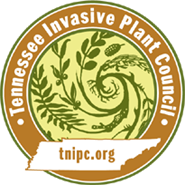Alliaria petiolata (Bieb.) Cavara & Grande
Alliaria petiolata (Bieb.) Cavara & GrandeGarlic Mustard
| Threat Level | Category |
|---|---|
| Established | Forb/Herb |
|
Similar Species May be confused with the following native and/or non-native species. Landscape Alternatives lists native horticultural substitutes |
Geum canadense Viola spp. |
|---|

Description
Height
First-year rosettes extend to 4 inches (10 cm) high. Flowering stems may reach 2.0-3.5 feet (0.6-1.1 m).Stems
One to several erect, slightly ridged, light green, stems rise from the same rootstock. They are hairless near the top of the stem and hairy lower down.Leaves
First-year leaves (which remain the second year) are round to kidney-shaped and are on stems approximately 2-3 inches (5.0-6.5 cm) tall. Leaves on flowering plants are alternate and are larger near the base of the stem. They are large-toothed, triangular to heart shaped, and approximately 1 inch (2.54 cm) or more long and 2-3 inches (5.0-7.5 cm) wide.Flowers
Small flowers grow in clusters at the end of the stems. Each flower has four white petals and is a quarter inch long. Blooms in spring, usually in late April to May. Occasionally, some plants will bloom again in July-August.Fruit
Fruit is a thin, ascending green capsule, called a silique, 1.0-2.5 inches (2.5-6.3 cm) long containing many seeds. Siliques are alternately whorled along the stalk and are produced summer to early fall. The capsules burst open when mature and explosively expel the seeds, dispersing them several meters.Seeds
Small, black seeds grow in a row inside the silique. Seeds may remain viable for up to 5 years. Plants can produce up to 868 seeds depending on habitat and population density. Seeds are dispersed by human/animal vectors or by water in riparian areas.Images
Photo: Chris Evans, River to River CWMA, Bugwood.orgMore images of Alliaria petiolata
Life History
Garlic mustard gets its name from its characteristic odor of garlic when the plant is crushed and its mustard-like appearance. It is a naturalized European biennial herb that poses a significant threat to lowland natural areas as well as gardens and field crops. It belongs to the Brassicaceae (Mustard) family.Garlic mustard is a cool-season obligate biennial herb with a slender taproot. Seeds germinate in early spring (April-May) of the first year resulting in initially high seedling densities. Natural mortality during the first year results in only 2%-4% of the plants surviving to flower the following spring. Garlic mustard is self- or cross-pollinated and a single plant can populate an entire site. Adult plants set and disperse seed in late spring (May-June) the second year and produce an average of 165-868 seeds. The seeds are dormant for 20 months germinating in early spring of year four.
Basal rosettes of leaves in the first year remain green during winter and produce one to several flower stalks the second year. The plant dies after seed formation in midsummer. Dead plants remain standing, and long slender seedstalks (each with a characteristic crook at the base) hold many upturned thin seed capsules. Garlic mustard is allelopathic, emitting chemicals to kill surrounding plants and microbes.
Habitat
Garlic mustard occurs most frequently in forested communities under partial shade. However, plants will grow on sites ranging from full shade to full sun, moist floodplains to dry, sandy forests, and in a wide variety of soils. Garlic mustard is associated with calcareous soils and is intolerant of acidic substrates. Disturbed forest and riparian communities are most susceptible to garlic mustard invasion and may dominate the herb strata within ten years. Garlic mustard will spread from disturbed areas to colonize undisturbed sites. Floodplain areas are particularly vulnerable since seeds are easily transported in water.Origin and Distribution
Garlic mustard was introduced from Europe as food or a medicinal herb. It was first recorded as an escaped weed in the U.S. in 1868 in Long Island, New York. By 1991, this exotic plant had spread to 28 midwestern and northeastern states. Other states where invasive: AK, CT, DC, DE, GA, IA, IL, IN, KY, MA, MD, ME, MI, MO, NC, NH, NJ, NY, OH, OR, PA, VA, VT, WI, WV. Federal or state listed as noxious weed, prohibited, invasive or banned: AL, CT, MA, MN, NH, OR, VT, WA.Sources: Information on this plant page derived primarily from the Tennessee Management Manual and James H. Miller's Nonnative Invasive Plants of Southern Forests, USDA Forest Service.
Management Recommendations
Mechanical Control
Hand Pull: This method of control is effective for small populations of garlic mustard, since plants pull up easily in most forested habitats. Hand-pulling is an extremely effective method of reducing population and seed productivity. Hand-pulling of plants can be done during most of the year. If plants have seed capsules present, they should be bagged and disposed of to prevent seed dispersal. Care should be taken to minimize soil disturbance. Resprouts are uncommon but may appear from mature plants not entirely removed.Cutting: This method is effective for medium- to large- sized populations depending on available time and labor resources. Cut stems when in flower (late spring/early summer) at ground level either manually or with a mechanical brush-cutter. This technique will result in almost total mortality of existing plants. Dormant seeds in the soil are unaffected by this technique. Treatments should be continued annually until the seedbank is exhausted.
